《爱玛》中的反讽艺术:基于言语行为理论的视角
奥斯丁之魂_试析_爱玛_中的情境反讽
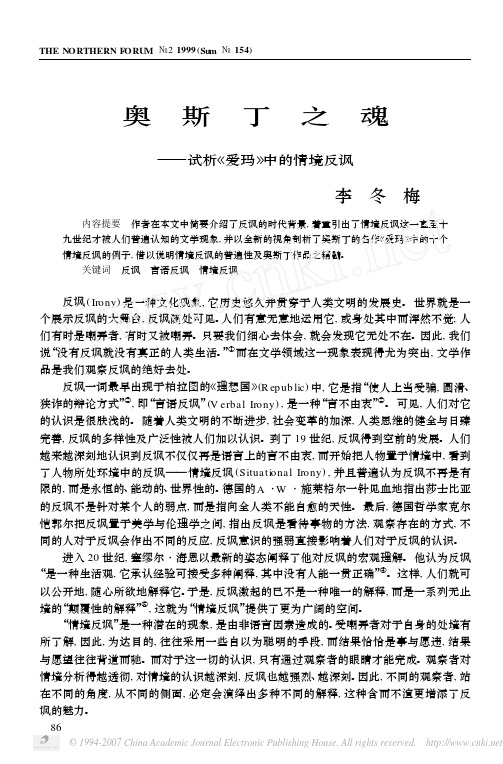
THE NORTHERN F ORU M№21999(Su m№154)奥斯丁之魂——试析《爱玛》中的情境反讽李 冬 梅内容提要 作者在本文中简要介绍了反讽的时代背景,着重引出了情境反讽这一直至十九世纪才被人们普遍认知的文学现象,并以全新的视角剖析了奥斯丁的名作《爱玛》中的十个情境反讽的例子,借以说明情境反讽的普遍性及奥斯丁作品之精髓。
关键词 反讽 言语反讽 情境反讽反讽(Irony)是一种文化现象,它历史悠久并贯穿于人类文明的发展史。
世界就是一个展示反讽的大舞台,反讽随处可见。
人们有意无意地运用它,或身处其中而浑然不觉;人们有时是嘲弄者,有时又被嘲弄。
只要我们细心去体会,就会发现它无处不在。
因此,我们说“没有反讽就没有真正的人类生活。
”①而在文学领域这一现象表现得尤为突出,文学作品是我们观察反讽的绝好去处。
反讽一词最早出现于柏拉图的《理想国》(R ep ub lic)中,它是指“使人上当受骗,圆滑、狭诈的辩论方式”②,即“言语反讽”(V erbal Irony),是一种“言不由衷”②。
可见,人们对它的认识是很肤浅的。
随着人类文明的不断进步,社会变革的加深,人类思维的健全与日臻完善,反讽的多样性及广泛性被人们加以认识。
到了19世纪,反讽得到空前的发展。
人们越来越深刻地认识到反讽不仅仅再是语言上的言不由衷,而开始把人物置于情境中,看到了人物所处环境中的反讽——情境反讽(Situati onal Irony),并且普遍认为反讽不再是有限的,而是永恒的、能动的、世界性的。
德国的A・W・施莱格尔一针见血地指出莎士比亚的反讽不是针对某个人的弱点,而是指向全人类不能自愈的天性。
最后,德国哲学家克尔恺郭尔把反讽置于美学与伦理学之间,指出反讽是看待事物的方法,观察存在的方式,不同的人对于反讽会作出不同的反应,反讽意识的强弱直接影响着人们对于反讽的认识。
进入20世纪,塞缪尔・海恩以最新的姿态阐释了他对反讽的宏观理解。
反讽:简·奥斯丁《爱玛》的艺术性建构
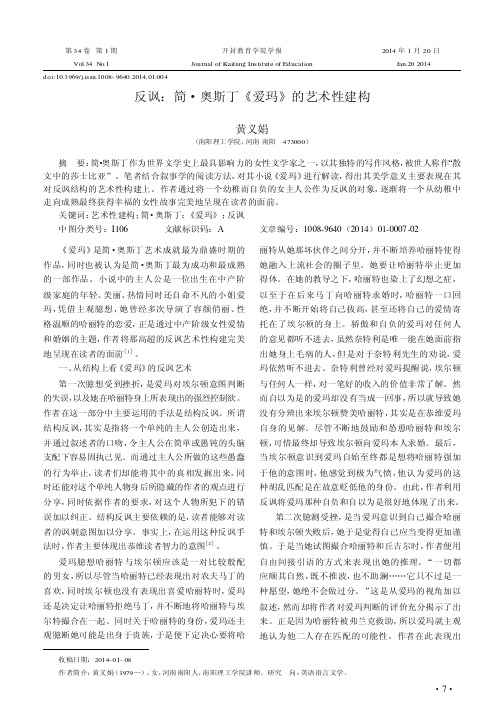
第34卷第1期Vol.34N o.1开封教育学院学报Journal of Kaifeng Institute of Education2014年1月20日Jan.202014·7·doi:10.3969/j.issn.1008-9640.2014.01.004《爱玛》是简·奥斯丁艺术成就最为鼎盛时期的作品,同时也被认为是简·奥斯丁最为成功和最成熟的一部作品。
小说中的主人公是一位出生在中产阶级家庭的年轻、美丽、热情同时还自命不凡的小姐爱玛,凭借主观臆想,她曾经多次导演了容颜俏丽、性格温顺的哈丽特的恋爱,正是通过中产阶级女性爱情和婚姻的主题,作者将那高超的反讽艺术性构建完美地呈现在读者的面前[1]。
一、从结构上看《爱玛》的反讽艺术第一次臆想受到挫折,是爱玛对埃尔顿意图判断的失误,以及她在哈丽特身上所表现出的强烈控制欲。
作者在这一部分中主要运用的手法是结构反讽。
所谓结构反讽,其实是指将一个单纯的主人公创造出来,并通过叙述者的口吻,令主人公在简单或愚钝的头脑支配下容易固执己见。
而通过主人公所做的这些愚蠢的行为举止,读者们却能将其中的真相发掘出来,同时还能对这个单纯人物身后所隐藏的作者的观点进行分享,同时依据作者的要求,对这个人物所犯下的错误加以纠正。
结构反讽主要依赖的是,读者能够对读者的讽刺意图加以分享。
事实上,在运用这种反讽手法时,作者主要体现出恭维读者智力的意图[2]。
爱玛臆想哈丽特与埃尔顿应该是一对比较般配的男女,所以尽管当哈丽特已经表现出对农夫马丁的喜欢,同时埃尔顿也没有表现出喜爱哈丽特时,爱玛还是决定让哈丽特拒绝马丁,并不断地将哈丽特与埃尔特撮合在一起。
同时关于哈丽特的身份,爱玛还主观臆断她可能是出身于贵族,于是便下定决心要将哈丽特从她那坏伙伴之间分开,并不断培养哈丽特使得她融入上流社会的圈子里。
她要让哈丽特举止更加得体。
在她的教导之下,哈丽特也染上了幻想之症,以至于在后来马丁向哈丽特求婚时,哈丽特一口回绝,并不断开始将自己拔高,甚至还将自己的爱情寄托在了埃尔顿的身上。
《爱玛》读后感
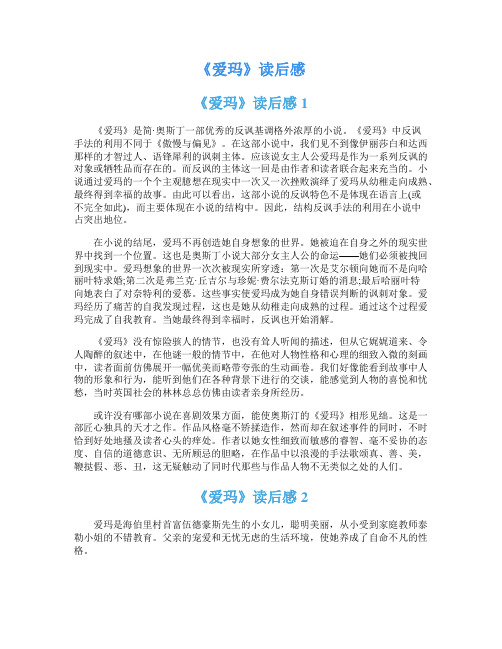
《爱玛》读后感《爱玛》读后感1《爱玛》是简·奥斯丁一部优秀的反讽基调格外浓厚的小说。
《爱玛》中反讽手法的利用不同于《傲慢与偏见》。
在这部小说中,我们见不到像伊丽莎白和达西那样的才智过人、语锋犀利的讽刺主体。
应该说女主人公爱玛是作为一系列反讽的对象或牺牲品而存在的。
而反讽的主体这一回是由作者和读者联合起来充当的。
小说通过爱玛的一个个主观臆想在现实中一次又一次挫败演绎了爱玛从幼稚走向成熟、最终得到幸福的故事。
由此可以看出,这部小说的反讽特色不是体现在语言上(或不完全如此),而主要体现在小说的结构中。
因此,结构反讽手法的利用在小说中占突出地位。
在小说的结尾,爱玛不再创造她自身想象的世界。
她被迫在自身之外的现实世界中找到一个位置。
这也是奥斯丁小说大部分女主人公的命运——她们必须被拽回到现实中。
爱玛想象的世界一次次被现实所穿透:第一次是艾尔顿向她而不是向哈丽叶特求婚;第二次是弗兰克·丘吉尔与珍妮·费尔法克斯订婚的消息;最后哈丽叶特向她表白了对奈特利的爱慕。
这些事实使爱玛成为她自身错误判断的讽刺对象。
爱玛经历了痛苦的自我发现过程,这也是她从幼稚走向成熟的过程。
通过这个过程爱玛完成了自我教育。
当她最终得到幸福时,反讽也开始消解。
《爱玛》没有惊险骇人的情节,也没有耸人听闻的描述,但从它娓娓道来、令人陶醉的叙述中,在他谜一般的情节中,在他对人物性格和心理的细致入微的刻画中,读者面前仿佛展开一幅优美而略带夸张的生动画卷。
我们好像能看到故事中人物的形象和行为,能听到他们在各种背景下进行的交谈,能感觉到人物的喜悦和忧愁,当时英国社会的林林总总仿佛由读者亲身所经历。
或许没有哪部小说在喜剧效果方面,能使奥斯汀的《爱玛》相形见绌。
这是一部匠心独具的天才之作。
作品风格毫不矫揉造作,然而却在叙述事件的同时,不时恰到好处地搔及读者心头的痒处。
作者以她女性细致而敏感的睿智、毫不妥协的态度、自信的道德意识、无所顾忌的胆略,在作品中以浪漫的手法歌颂真、善、美,鞭挞假、恶、丑,这无疑触动了同时代那些与作品人物不无类似之处的人们。
探析《爱玛》中的反讽语言艺术

探析《爱玛》中的反讽语言艺术作者:刘宁宁来源:《语文建设·下半月》2015年第08期摘要:简·奥斯汀的代表作《爱玛》展示了作家语言的驾驭力。
作家凭借其讽刺语言的灵活运用受到世界读者欢迎,并形成了小说独有的艺术风格。
笔者以小说《爱玛》为载体,针对小说中的反讽语言进行分析,从而感受《爱玛》中语言的反讽表达,并深刻理解小说的主题内涵。
关键词:语言小说反讽《爱玛》引言简·奥斯汀既是英国19世纪有名的女作家,同时也是对世界文学历史产生了极其重要作用的作家之一。
在其诸多小说之中,奥斯汀利用反讽的手段对其经历的那个时期的人物作出了令人称道的剖析。
她的作品折射出那个时期中产阶级女性所面临的某些道德状况。
《爱玛》是她的第五部小说,这部作品的主题是爱情与婚姻,同时这也是最为大家广泛认可,写作手法最为老练成熟的作品。
在书中,奥斯汀描写了女主角怎样用百般手段脱离错误的选择,最后完善了自我,进入成熟情感的境界。
长期以来,各个国家的专家都关注着《爱玛》,特别是其中的反讽艺术。
为了解析《爱玛》里的反讽手段,有许多专家从小说的主旨以及角色的内心活动特点还有性格对小说展开了探索研究。
一、反讽语言的风格综述“反讽”这个词语起源希腊,在古代有三类意义:第一是假装不知道;第二是苏格拉底式的反讽,就是对手处于其连续不断诘问情况下暴露的可疑之处;第三是罗马式反讽,即词组表面意思和实质含义不相符合或者是截然相反。
大众概念里的反讽是在第三种类型的根基之上汇合现代反讽要素,它的关键表现在语言和含义两者间的对峙。
[1]在叙事文当中,反讽被使用得相当广泛。
在当事人某一些尖锐的语言里,有时候存在着表面和内里两个声音,这是语言反讽。
有的时候,当事人不动声色,只是利用人物的行为和语言展现出语言和含义的差别和对立,这是情景反讽。
假如作家故意将小说的情节、架构或角色,大概与大家熟悉的某个神话历史平行,进而使每个比照都得到小说对神话的反讽,这就是结构反讽。
言语行为理论视角下的反讽话语理解
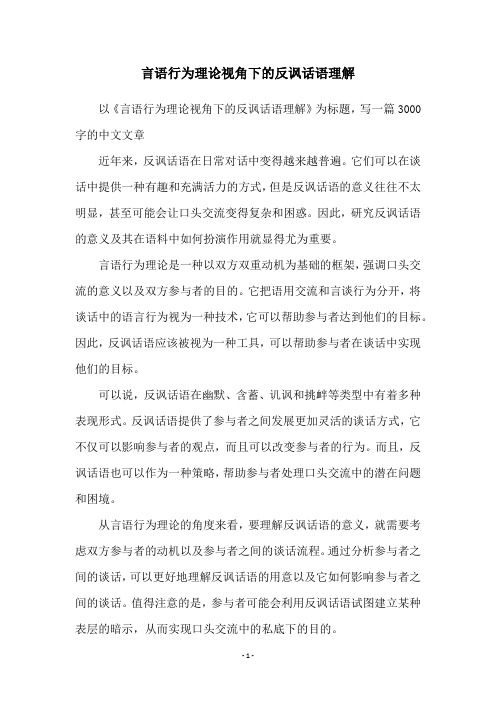
言语行为理论视角下的反讽话语理解以《言语行为理论视角下的反讽话语理解》为标题,写一篇3000字的中文文章近年来,反讽话语在日常对话中变得越来越普遍。
它们可以在谈话中提供一种有趣和充满活力的方式,但是反讽话语的意义往往不太明显,甚至可能会让口头交流变得复杂和困惑。
因此,研究反讽话语的意义及其在语料中如何扮演作用就显得尤为重要。
言语行为理论是一种以双方双重动机为基础的框架,强调口头交流的意义以及双方参与者的目的。
它把语用交流和言谈行为分开,将谈话中的语言行为视为一种技术,它可以帮助参与者达到他们的目标。
因此,反讽话语应该被视为一种工具,可以帮助参与者在谈话中实现他们的目标。
可以说,反讽话语在幽默、含蓄、讥讽和挑衅等类型中有着多种表现形式。
反讽话语提供了参与者之间发展更加灵活的谈话方式,它不仅可以影响参与者的观点,而且可以改变参与者的行为。
而且,反讽话语也可以作为一种策略,帮助参与者处理口头交流中的潜在问题和困境。
从言语行为理论的角度来看,要理解反讽话语的意义,就需要考虑双方参与者的动机以及参与者之间的谈话流程。
通过分析参与者之间的谈话,可以更好地理解反讽话语的用意以及它如何影响参与者之间的谈话。
值得注意的是,参与者可能会利用反讽话语试图建立某种表层的暗示,从而实现口头交流中的私底下的目的。
此外,要理解反讽话语的意义,参与者之间的文化背景也是不可忽视的一个因素。
不同的文化背景可能会影响参与者之间的谈话,从而影响反讽话语的意义推断。
而且,可以利用文化背景来解释反讽话语在一个特定社会或文化中的含义。
本文通过讨论言语行为理论观点,来研究反讽话语在日常口头交流中的用意。
双方参与者的动机、参与者之间的谈话流程、参与者之间的文化背景都可以影响反讽话语的含义推断,因此可以用言语行为理论的概念来解释反讽话语的用意。
通过深入理解反讽话语,我们也可以更好地理解口头交流的本质,为更加流畅的口头交流提供基础。
总之,言语行为理论是一种有用的理论框架,可以用来更好地理解反讽话语的意义和用途,以及它们如何影响口头交流的效果。
言语行为理论视角下《爱玛》中的反讽探究

言语行为理论视角下《爱玛》中的反讽探究言语行为理论视角下《爱玛》中的反讽探究李园摘要:《爱玛》是简·奥斯丁最具影响力的代表作之一,作者通过人物言语行为与其意图相背离的方式,形成了独具特色的反讽效果。
本文以微观与宏观言语行为理论为视角,对《爱玛》中反讽的运用进行论述,期望对读者深入认知《爱玛》的语言艺术有所帮助。
关键词:言语行为;《爱玛》;反讽简·奥斯丁是一位女性小说家,谱写了大量流传后世的经典之作,如《傲慢与偏见》、《爱玛》等等。
她的大多数作品都是以描写英国中产阶级年轻女性的婚恋故事为主,作品中除了有着田园情调之外,还有浓重的反讽色彩。
《爱玛》是简·奥斯丁生前所创作的最后一部文学作品,也是一部具有鲜明时代特征的经典反讽之作。
一、微观言语行为视角下《爱玛》中的反讽从微观语用学角度来看,《爱玛》对反讽语言的应用主要体现为言语行为理论中的阐述类、承诺类和表达类三个方面。
(一)阐述类阐述类是言外行为中的第一类,指以陈述或描述的方式,对某个事实表达自己意图的言语行为。
简·奥斯丁在创作《爱玛》时,从故事的一开始便运用了阐述类的方式,简要介绍了主人公爱玛的外在形象与性格,作者在描述时,使用了这样一句话,“看起来像是一个享受最美好祝福的存在”。
开篇的这段阐述是主人公爱玛情况的一个简要描述,并告知读者,爱玛有着让大多数人羡慕的条件,她集聪明、漂亮、富有于一身,这种表达是否为作者的真正意义传达是一个非常耐人寻味的问题。
之所以会对这些近乎完美的条件产生怀疑,主要是这段话中出现了一个词语,即“看起来像”,从中可以给人这样的感觉,即所有的描述虽然真实,但却并非作者所要表达的本意。
在对作品继续阅读后,便可以发现,主人公爱玛确实聪明,但只是自作聪明,她的富有却导致了自以为是的性格。
由此可知,作者开篇时的描述,与作者期望读者了解的爱玛并不相同。
由言语行为理论可知,当意图与言语意思相违背时,便会产生出一定的反讽效果。
从言语反讽视角看《爱玛》中的人物性格特征

从言语反讽视角看《爱玛》中的人物性格特征摘要运用奥斯汀&塞尔提出的言语行为理论,深入剖析简?奥斯丁小说《爱玛》中各类反讽言语行为。
通过对《爱玛》中的话语进行分析及归类,从言外行为和言后行为视角出发,对人物性格特征做出鉴析并分析其教育意义。
关键词:《爱玛》反讽性格特征教育意义《爱玛》以19世纪的英国为写作背景,描写了海伯里村首富名叫伍德豪斯先生的小女儿爱玛通过不断地暴露自己的弱点、经历不断的挫折最终走向道德完善和情感成熟的过程,是一部典型的女性成长教育小说。
她曾把这部作品献给当时的摄政王,可见其作品的社会地位。
其反讽的运用达到了炉火纯青的境界,细腻的笔触、巧妙的对话和精确的语言,把平常的小事凡人勾勒得有滋有味,让人仿佛身临其境,所以此部小说曾被视为“最伟大最具有代表性的作品”。
反讽一词最早出现在柏拉图的《理想国》中,意思为“使人受骗上当,欺诈、圆滑的辩论方式”,然而反讽真正被研究始于亚里士多德。
在文学中,它既是一种修辞技巧,也是表达与主题相左的一种语言组织方法。
在小说《爱玛》中,反讽不仅仅是一种修辞手法,更多的是借助相反的话来塑造具有鲜明特征的人物形象以达到揭露某个人性格特征的效果,具有某种教育目的。
简?奥斯丁在《爱玛》中运用反讽修辞手法向读者们呈现出一幅幅生动的人物图像,其中人物角色之间的反讽性对话更是吸引了许多学者的关注。
然而,这些研究大都是从言外行为的角度对反讽手段进行说明,忽视了言后行为在营造反讽氛围和塑造人物形象的重要作用。
因此,本文将运用奥斯汀&塞尔言语行为理论中的言外和言后行为剖析《爱玛》中反讽性会话,并对人物性格特点进行分析,以更好地在言语行为理论框架下诠释简?奥斯丁笔下生动的人物形象。
一文学与言语反讽自荷兰著名语言学家van dijk开始关注依靠语用学方法来研究文学作品,到上世纪70年代末,文学和语用学进入了空前的发展阶段,从而有了一个新的交叉学科――文学语用学。
言语行为理论【言语行为理论在《爱玛》中的体现】

言语行为理论【言语行为理论在《爱玛》中的体现】《爱玛》英国现实主义小说家简•奥斯丁的作品。
在这部机智风趣小说的小说中,奥斯丁把文章叙述和人物对话巧妙结合,让角色的鲜明个性都透过不同的说话风格得到体现,令读者印象深刻。
整部作品围绕着海伯里村首富伍德豪斯先生的女儿爱玛展开,通过她乱点鸳鸯谱闹出来的种种误会,描述了三对不同类型的年轻情侣,反映了当时英国的社会风俗和婚姻状况。
文学作品中的语言虽然是经过作家艺术化的语言,但仍是来源于日常的生活,所以一部作品可以看做是作家的许多个言语行为的集合。
本文旨在通过语用学中的言语行为理论,对《爱玛》中的叙述和人物对话进行分析,以更好地理解作者的创作艺术。
2言语行为理论和反讽英国语言哲学家J.Austin于1955年首先提出了言语行为理论,即认为人们在以言行事。
人类交际的基本单位不是符号,词或句子,而是被完成了的某种言语行为。
一个人在说话时,大多数情况下同时实施了三种行为:言内行为,言外行为和言后行为。
言内行为即指‘说话’这一行为本身,它并不构成语言交际。
言外行为是通过‘说话’这一动作所实施的一种行为。
人们通过说话可以做许多事情,达到各种目的。
同时Austin还提出了使言语行为实现的三个条件:1)说话人必须是具备实施某一行为条件的人;2)说话人必须对自己说出的要去实施的行为抱有诚意;3)说话人对自己所说的话不能反悔。
Searle进一步对言语行为理论的内部结构进行分析,对言外行为做了分类。
第一,行为目的的差别。
各种言外行为的目的是不一样的;第二,言语与世界适应方向的差别。
或者使词适应世界,或者使世界适应词;第三,所表达的心理状态的差别。
在完成一个有命题内容的言外行为中,说话人总要表达某种心理状态或心理活动。
按照这样的标准,Searle将言外行为,即人们使用语言的方式分为五类:断言式、指向式、承诺式、表达式和宣言式。
同样地,“Searle把诚意条件看做是实施任何言语行为时所固有的必须条件。
开题——浅析《爱玛》中的反讽艺术
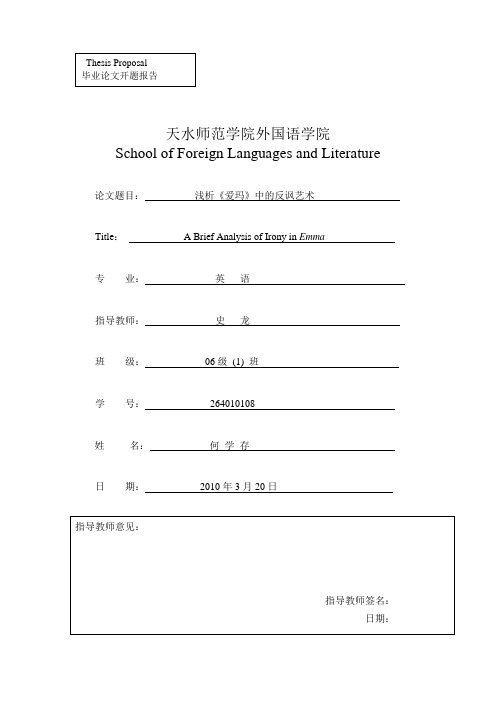
[3]Guerin ,Wilfred L, Morgon ,Lee, Reesman, Jeanne C, Willingham ,John R, Labor, Earle G.AHandbook of Critical Approaches to Literature[M],Oxford University Press,1992.
2 国内对《爱玛》的反讽研究
简·奥斯丁,她的讽刺对象主要是社会生活中“玉在椟中求善价,钗于奁内待时飞”的婚姻状况当然,她也对感性多于理性的妇女进行了温和的讽刺(刘丹翎,2002:145)。作为其代表作品之一的《爱玛》正是运用反讽手法,让表象和事实互成对照,在不知觉的态度下产生喜剧效果并描述女主人公如何走出一个个错误而步入道德完善和情感成熟的过程。在《爱玛》中,奥斯丁创作了一系列的漫画人物而且他们的出场总是伴随着喜剧气氛和机智的反讽(高光明,孙利,2000:1)。本文将通过对小说《爱玛》中所运用的三种反讽类型:言语反讽、戏剧反讽、情景反讽,探讨各种反讽在小说中的关键作用。
[18] 王智华.“ 奥斯丁小说《傲慢与偏见》和《爱玛》中的反讽艺术”[J],《河北建筑科技学院学报》,2004(4).
[19]杨正和.奥斯丁小说的反讽艺术辨析[J],《上饶师专学报》,1997(7).
[20] 朱虹.《奥斯丁研究》[M],北京:中国文联出版社,1985.
2010年5月中旬--------------------------------------定稿
《爱玛》叙事角度的反讽语境分析

《爱玛》叙事角度的反讽语境分析摘要在《爱玛》这部叙事佳作中,简・奥斯丁充分发挥了叙事技巧的作用,对文学作品进行了详尽的论述。
小说不断转换着叙事视角,而变幻着的叙事技巧不仅缩短了人物与读者的心理距离,使读者产生亲切感;还对读者的情感起到一定的控制作用。
读者会不自觉地站在人物的立场,因此也会随着人物的情感发生相似的心理波动,这也为读者提供了反讽的条件。
爱玛这一自负的形象,其实是小说叙事的反讽对象。
笔者旨在对小说的叙事及其反讽进行探析,让读者更能清晰把握小说的a反讽效果。
关键词:《爱玛》简・奥斯丁叙事视角反讽中图分类号:I106.4 文献标识码:A一引言《爱玛》是简・奥斯丁优秀的反讽小说。
相对于其反讽小说《傲慢与偏见》,《爱玛》的影响的确不大,但其艺术手法上却达到了炉火纯青的地步。
简・奥斯丁曾把《爱玛》献给英国摄政王,由此可见,其作品的重要地位。
而且,这部小说曾一度被视为奥斯丁所写过的“最伟大最具有代表性的作品”。
将故事与反讽话语进行交织的语言习惯和叙事角度是《爱玛》这部小说极具风格和巧妙之处。
简・奥斯丁曾说其小说不仅能使妇女感到愉悦,同时还对妇女有一定的教育意义。
《爱玛》正是对其观点的例证,这部小说常被人们视为对爱玛进行了一次再教育。
小说并不是以说教的形式来呈现的,而是通过主人公不断的经历挫折,并将自身的弱点一次次地暴露出来,将其自负、自私、自傲的性格与现实的格格不入进行对照。
二小说的叙事视角与声音小说最早出现于16世纪末英国文艺复兴时期。
出现初期发展缓慢,这一文学体裁并没有重大的突破。
然而随着经济的日益发展,文学也得以繁荣,在此期间英国的小说以及小说写作技巧不断发展并有所突破。
简・奥斯丁便是这一方面的先驱,她特立独行的叙事角度和叙事技巧为其在小说中的应用和发展作出了突出的贡献。
19世纪初,许多著名的批评家,开始用小说的“叙事视角”对一些作品进行分析。
“叙事视角”是指叙述者或人物与所叙述的文本中的具体事件之间形成的某种对应的位关系。
基于关联理论的情景反讽在《爱玛》中的应用
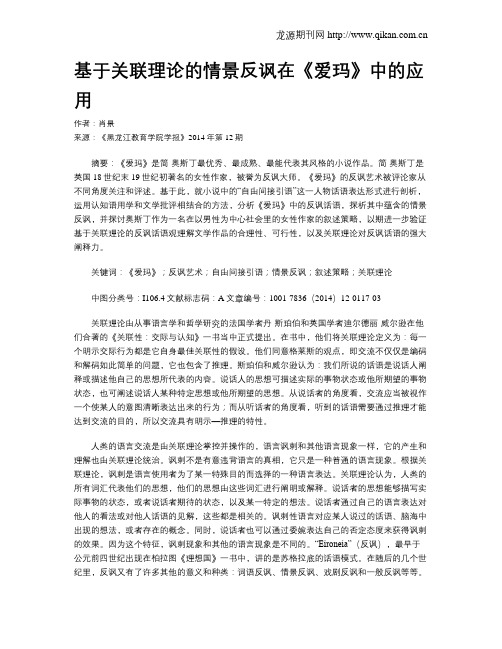
基于关联理论的情景反讽在《爱玛》中的应用作者:肖景来源:《黑龙江教育学院学报》2014年第12期摘要:《爱玛》是简·奥斯丁最优秀、最成熟、最能代表其风格的小说作品。
简·奥斯丁是英国18世纪末19世纪初著名的女性作家,被誉为反讽大师。
《爱玛》的反讽艺术被评论家从不同角度关注和评述。
基于此,就小说中的“自由间接引语”这一人物话语表达形式进行剖析,运用认知语用学和文学批评相结合的方法,分析《爱玛》中的反讽话语,探析其中蕴含的情景反讽,并探讨奥斯丁作为一名在以男性为中心社会里的女性作家的叙述策略,以期进一步验证基于关联理论的反讽话语观理解文学作品的合理性、可行性,以及关联理论对反讽话语的强大阐释力。
关键词:《爱玛》;反讽艺术;自由间接引语;情景反讽;叙述策略;关联理论中图分类号:I106.4文献标志码:A文章编号:1001-7836(2014)12-0117-03关联理论由从事语言学和哲学研究的法国学者丹·斯珀伯和英国学者迪尔德丽·威尔逊在他们合著的《关联性:交际与认知》一书当中正式提出。
在书中,他们将关联理论定义为:每一个明示交际行为都是它自身最佳关联性的假设。
他们同意格莱斯的观点,即交流不仅仅是编码和解码如此简单的问题,它也包含了推理。
斯珀伯和威尔逊认为:我们所说的话语是说话人阐释或描述他自己的思想所代表的内容。
说话人的思想可描述实际的事物状态或他所期望的事物状态,也可阐述说话人某种特定思想或他所期望的思想。
从说话者的角度看,交流应当被视作一个使某人的意图清晰表达出来的行为;而从听话者的角度看,听到的话语需要通过推理才能达到交流的目的,所以交流具有明示—推理的特性。
人类的语言交流是由关联理论掌控并操作的,语言讽刺和其他语言现象一样,它的产生和理解也由关联理论统治。
讽刺不是有意违背语言的真相,它只是一种普通的语言现象。
根据关联理论,讽刺是语言使用者为了某一特殊目的而选择的一种语言表达。
解读《爱玛》中的反讽艺术
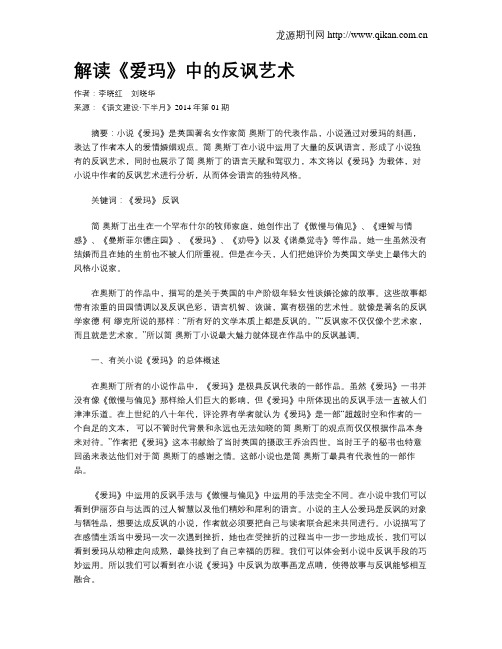
解读《爱玛》中的反讽艺术作者:李晓红刘晓华来源:《语文建设·下半月》2014年第01期摘要:小说《爱玛》是英国著名女作家简·奥斯丁的代表作品,小说通过对爱玛的刻画,表达了作者本人的爱情婚姻观点。
简·奥斯丁在小说中运用了大量的反讽语言,形成了小说独有的反讽艺术,同时也展示了简·奥斯丁的语言天赋和驾驭力,本文将以《爱玛》为载体,对小说中作者的反讽艺术进行分析,从而体会语言的独特风格。
关键词:《爱玛》反讽简·奥斯丁出生在一个罕布什尔的牧师家庭,她创作出了《傲慢与偏见》、《理智与情感》、《曼斯菲尔德庄园》、《爱玛》、《劝导》以及《诺桑觉寺》等作品。
她一生虽然没有结婚而且在她的生前也不被人们所重视。
但是在今天,人们把她评价为英国文学史上最伟大的风格小说家。
在奥斯丁的作品中,描写的是关于英国的中产阶级年轻女性谈婚论嫁的故事。
这些故事都带有浓重的田园情调以及反讽色彩,语言机智、诙谐,富有极强的艺术性。
就像是著名的反讽学家德·柯·缪克所说的那样:“所有好的文学本质上都是反讽的。
”“反讽家不仅仅像个艺术家,而且就是艺术家。
”所以简·奥斯丁小说最大魅力就体现在作品中的反讽基调。
一、有关小说《爱玛》的总体概述在奥斯丁所有的小说作品中,《爱玛》是极具反讽代表的一部作品。
虽然《爱玛》一书并没有像《傲慢与偏见》那样给人们巨大的影响,但《爱玛》中所体现出的反讽手法一直被人们津津乐道。
在上世纪的八十年代,评论界有学者就认为《爱玛》是一部“超越时空和作者的一个自足的文本,可以不管时代背景和永远也无法知晓的简·奥斯丁的观点而仅仅根据作品本身来对待。
”作者把《爱玛》这本书献给了当时英国的摄政王乔治四世。
当时王子的秘书也特意回函来表达他们对于简·奥斯丁的感谢之情。
这部小说也是简·奥斯丁最具有代表性的一部作品。
《爱玛》中运用的反讽手法与《傲慢与偏见》中运用的手法完全不同。
开题——浅析《爱玛》中的反讽艺术

1 引言
1.1 作者及其作品《爱玛》的介绍
1.2 文献综述
1.2.1国外研究
1.2.2国内研究
2 反讽的含义、类型及其特点
2.1 反讽的由来及其发展
2.2反讽的类型及各种反讽类型的特点
3 简·奥斯丁的反讽手法概述
4 小说《爱玛》中出现的反讽类型及各种反讽类型的运用
4.1 《爱玛》中的言语反讽
2010年3月下旬---------------------------------------初稿
2010年4月上旬--------------------------------------第二稿
2010年5月上旬--------------------------------------第三稿
指导教师意见:
指导教师签名:
日期:
一、选题的目的和意义
选题的目的:通过对小说《爱玛》的分析,探讨作品中反讽手法的运用及其价值和意义。
选题的意义:通过研究反讽,包括言语反讽,情景反讽和戏剧反讽在简·奥斯丁的作品《爱玛》中的具体体现来揭示反讽这一修辞手法在文本中的价值及意义,这有助于我们从新的角度理解小说《爱玛》,进一步认识简·奥斯丁的创作成就和文学地位,同时也对我们学习与借鉴她的语言艺术和创作风格有着积极的作用。
三、选题的重点和难点
选题的重点:本选题主要分析各种反讽手法在小说《爱玛》中的价值及意义。
选题的难点:将反讽理论具体地与作品结合起来分析各种反讽手法在文本中的价值和意义。
四、研究步骤、方法及措施
研究步骤:1 收集资料
2 整理参考资料
3 组织论证
4 确定论文基本框架
5 撰写论文
研究方法与措施:查阅资料,文献分析
浅析《爱玛》中的反讽艺术
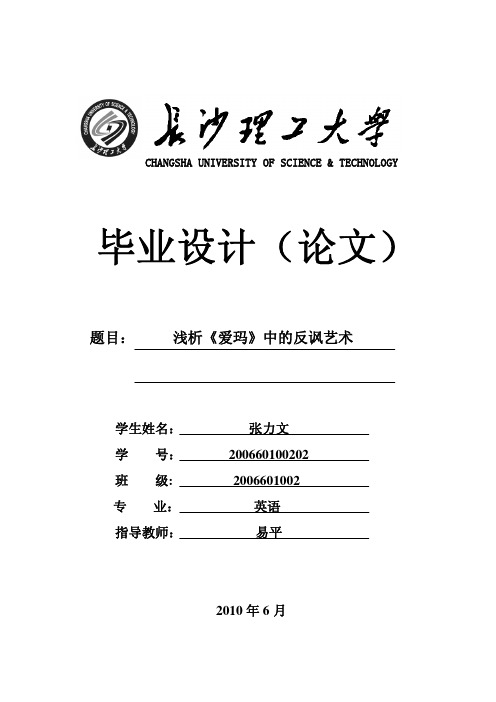
CHANGSHA UNIVERSITY OF SCIENCE & TECHNOLOGY 毕业设计(论文)题目:浅析《爱玛》中的反讽艺术学生姓名:张力文学号: 200660100202班级: 2006601002专业:英语指导教师:易平2010年6月GRADUATION THESIS(Grade 2006)ANALYSIS THE ART OF IRONEY IN EMMAName:Zhang LiwenNumber: 200660100202Class: 2006601002Tutor: Yi PingDepartment: School of Foreign Languages Date of Completion: June 18, 2010浅析《爱玛》中的反讽艺术摘要简·奥斯丁是英国十九世纪杰出的小说家。
在《爱玛》这部小说中,反讽技巧成为奥斯丁小说中的一个显著特色。
本文从反讽类型和特点的分析上,讨论了《爱玛》中的各种反讽手法,以及这些反讽手法对人物形象刻画和情节发展等方面的作用,并以反讽艺术效果的角度说明了《爱玛》是一部极具反讽特点的小说,作者简·奥斯丁也是一位优秀的反讽大师。
本文通过《爱玛》这部作品来看简·奥斯丁对于反讽的运用。
本文共分三个部分。
第一部分讲述了简·奥斯丁以及爱玛。
第二部分介绍小说《爱玛》的写作背景,包括现实主义和功利主义。
第三部分介绍了爱玛当中反讽的运用,并介绍了多种反讽用法在作品中的体现。
关键词:《爱玛》;反讽;简·奥斯丁ANALYSIS THE ART OF IRONEY IN EMMAABSTRACTJane Austen is an outstanding novelist in the 19th century. In Emma the irony skill becomes a significant characteristic in Austin’s novel. This novel analyzes the characteristics and types of the irony and describes various kinds of irony in Emma. This figure of irony has effect on the characters and promotes the plot development. In Emma we can see the special feature of irony from the irony art. Jane Austen is indeed a good master of irony. In this paper, we can see the irony used by Jane Austen through Emma. This paper has three parts in all. The first part introduces Jane Austen and gives a brief introduction to Emma. The second part introduces the writing background of Emma, including realism and utilitarianism. The third part analyzes the irony in Emma and introduces many kinds of irony.Key words:Emma; irony; Jane AustenContentsIntroduction (1)1 Jane Austen and Her Novel Emma (3)1.1 The Author of Emma: Jane Austen (3)1.2 The Introduction of Emma (4)2 The Writing Background of Emma (6)2.1Realism (6)2.2 Utilitarianism (6)3 The Art of Irony in Emma (8)3.1 Definition of Irony (8)3.2 The Use of Irony by Austen (8)3.3 Use of Irony in Emma (9)3.3.1 Irony in the Characterization of Emma and Mr.Knightley (9)3.3.2 Irony in Plot Structure (11)Conclusion (13)Bibliography (14)Acknowledgements (15)IntroductionEmma is a mature work written by British writer Jane Austen. In Emma Austen showed us the love and marriage of the British middle class in the 18th century. In the book there are three pairs of men and women who eventually tie the knot. They are Frank Churchill and Jane Fairfax, Emma Woodhouse and Mr.Knightley, Robert Martin and Harriet Smith. It is recorded that Austen in 1814 started writing Emma and finished in 1815. It is the fourth published works of Austen. At that time Austen was 40 years old and that period was the best time of her life. Because of her life experiences, her work was relatively mature this period. Not only the performance of art but also the ideas are relatively mature. Those who read Emma can find Austen's performance art have certainly achieved at a high stage.Emma has shaped a successful character - Emma. It is different from Jane Austen's other heroines in the books because Emma is not perfect. Anthony Trollope has pointed out that the heroine Emma was easy to make mistakes. In each section of the book she was wrong, because of her stupidity, vanity and ignorance, or because of her selfishness .Even Austen also worried that she has created a heroine that nobody liked but her. Emma's shortcomings are numerous, for example, she despised others. She liked to think something strange or to introduce girlfriend or boyfriend to others, and to cause harm to others. She always thinks herself right and does not like to listen to others. And she often insists on something. She loves to make jokes of somebody, and when she succeeds she always feels triumphant.Emma is a successful work that used irony. Irony plays a decisive part in plot development. The verbal irony and the situational or dramatic irony used in the dialogues are especially important. Based on the understanding of the reader-response criticism, this paper attempts to analyze the use of irony in Emma. Through a careful examination of the different types of irony used, the authoress seeks the understanding of the reader-response criticism. Meanwhile, the authoress tries to prove that irony contributes greatly to the characterization, structure, and theme of the novel.The British literature in 18th century is a very important era in the history. In this period,the literary creation of their language has some unique features,such as: simple language, concise, intelligent and sophisticated. No matter a poet, prose writer, or scholars, all kinds of artists try to link the artistic and witty, humorous, and irony knot together. In addition, the writers also combine those performances with the humor and Irony. Irony is a method of assertion used by authors in literature and poetry. Although many writers have employed this literary technique for centuries, the meaning of the word can be difficult to understand. Irony first appeared in Plato's book. The use of irony began with Aristotle. As one of the writing skills using in traditional literature, irony is a language skill, also a skill connected with characters, plot or theme, and it is the method of linguistic organization. The definition indicated that irony could be closely related to terms such as satire or sarcasm. The use of irony in Emma is different from other books. The irony in Emma is more of education and with the way of irony we can reach the purpose to educate people.1 Jane Austen and Her Novel EmmaWe have discussed the background of this book. Then, next we should know something about the use of irony by Jane Austen.1.1 The Author of Emma:Jane AustenJane Austen (December 16, 1775-July 18, 1817), an English novelist. She was born in Steve Burton, in rural town. There were six brothers and one sister in her home. Her father, George Austen (George Austen, 1731-1805) was a local pastor. Her mother was Cassandra (1739-1827). Austen had not been to regular school, but she had received good family education. The main material books were her father’s literary books. All the Austen family members loved reading popular fiction and the books were entertainment products. When she was a girl, she used copy the popular fiction, thus forming a mocking tone in her work. She began writing around the age of 20 and 6 novels were published all her life [1].Jane Austen never married all her life. In 1796, she and the highest Irish judges Tom Lefroy had a brief romance. It was said that he was the model of Mr. Darcy in Pride and Prejudice. In 1802, a little-year-old wealthy man Harris proposed to her. Austin initially accepted, but she changed her mind and rejected the next day.1801, when Austen's father retired, the whole family moved to the health resort of Bath. As described by the heroine Anne Elliot, Austen did not like Bath, which was perhaps about her family increasingly limited of the economic situation.1805 after the death of his father, Austen with her mother and sister went to the Southampton lived with his brother Frank for a few years. In 1809 they moved to Chawton with his brother Edward. Where the house is now the Austen’s Museum, and it has become a popular tourist spot. Austin’ lately writing works were written there.1816, Austen's health deteriorated. She moved to Winchester’s infirmary in 1817 and died in the same year in July. She was buried in Winchester Cathedral.From the late 18th to early 19th century, vulgar and boring sentimental novels and Gothic novels were full of the British literary scene. But Austen's novel created a new stage.Her works often ridiculed people's stupidity, selfishness, snobbery and blind self-confidence and despicable ridiculous weakness by the comic scenes. Austen's novel appeared in the early 19th century and drived away the rage of the false romantic trend. It inherited and developed the 18th-century British realist tradition and prepared for 19th-century realistic novel’s climax. Although her work reflected the breadth and depth limited, her works were useful. People can see the whole social forms and ways of the world from a small window. It played a good role to change the time on the vulgar culture novels, and it had a connecting sense in the history of the British novel. She was the writer known as the status of equal position with Shakespeare.1.2 The Introduction of EmmaThe British writer Jane Austen’s novel Emma is more influential, and it is written in 1815. This book is the most mature one of Austen’s novel.Emma is the richest man’s daughter in the village Highbury. When Emma was a little girl, she was intelligent and beautiful. She received a good education from her teacher Miss Taylor. Her Father's love and carefree living environment lead her to adopt a pretentious personality. When Emma was 12 years old, Miss Taylor married a gentleman near Weston and leaves Woodhouse. Emma feels lonely and recognizes a girl of the local schools named Harriet, and she makes friends with her. Harriet is a natural daughter, looks pretty, and has gentle character, and is very cute.Emma tries to match Harriet and the young gentleman Elton, and asks Harriet to refuse Robert Martin's marriage proposal. In fact the girl whom Elton loves girl is not Harriet, but Emma. So Emma does not match successful for them. Emma arranges another marriage for Harriet and this time she chooses Weston's son for Harriet.However, six months ago he met Highbury Frank Family's niece, Jane Fairfax. They attracted each other and set the marriage privately. Emma always intervenes of others marriage. A friend of her family tells Emma that people should be allowed to independently deal with love or people will get things worse. Knightley thinks highly of Robert Martin and often helps Harriet. In this way Harriet has a feeling of reverence and love to Knightley.When Emma discovers Harriet’s loving to Knightley, she is shocked. Because she realizes that she has been quietly in love with Knightley. At the same time, Knightley often points out the shortcomings of Emma; in fact, he is also interested in her [2].After a series of setbacks, Knightley and Emma finally get together. With Knightley'shelp Robert Martin eventually gets the love of Harriet.In Emma there are two important hero and heroine, that is Emma and Mr. Knightley. In many occasions they are in their own way to help others. The way for Emma to introduce girlfriend or boyfriend for others is ridiculous and even absurd in some degree. She is trying her best to help the low status of women looking for spouses of higher social status. She always misunderstands the situation, and the result is often contrary to her desire. Also it makes many jokes. We may think the author's aim is to make the readers laugh at the bad habit of British society.Mr. Knightley uses another way to help others, for example, once in a ball, he sees the low social status of Harriet faced with cold treatment, and by that he stands up to help maintaining her self-esteem. At last he helps her through the awkward situation. He thinks highly of Harriet and Martin’ true love in low status and gives appropriate assistance to them. He enables them the opportunity to tie the knot in accordance with their wishes. Emma is friendly, and she changes herself from lonely to make friends, from not knowing love to deep in love with Mr.Knightley. These all help Emma grow and become mature.2 The Writing Background of EmmaBefore we analyze the irony of Emma, it is necessary for us to know the background of Emma first. All these will be dealt with in following.2.1 RealismRealism was a literature movement which first appeared in the 19th century in France and Britain. Later it spread to Russia, Northern Europe and the United States. It became the mainstream in European and American’s literature in 19th century, and also created the modern European and American literacy’s climax.Realism is not only a world view, but also a form that contains a variety of viewpoints and realist theory. First of all, realism is a long-standing philosophical tradition and world view. Realism as a view of the world, is based on its moral progress and understanding of human capacity. Realists think the history is cycled not progressive. They are in deep suspicion of whether people have the ability to cooperate, live peacefully with each other and overcome the human recurring conflict. The world view of the realistic could see more evil in human nature and the tragedy in the cycle of human experience. To the middle of Emma, we can no longer doubt the reality of Jane Austen’ novel. Austen's novels are the Britain's secular painting in Victorian era. Austen is good at writing marriage. Acute vision is the writers’ essential tool for dealing with writing materials no matter what kind of writing style and writing genre is. Through her unsuccessful love, Austen does not become a woman who complained everything or a normal woman. Instead, she realized the essence of marriage is money and status. Take Emma for example, why Emma did not in favor of natural daughter Harriet and the famer Martin’s marriage? First of all, Emma arbitrarily considers Harriet is a daughter of a rich man, but Martin is a farmer with rude manner and penniless. Second, Emma does not think Martin has enough money to maintain their marriage.2.2 UtilitarianismUtilitarianism was officially becoming philosophy system in the late 18th and early 19thcentury. It is mentioned by the British philosopher and economist Bentham and Mill. The basic principle is: if an act could help enhance the happiness, it is right; if it appeared something on contrary with happiness, then it is wrong. Happiness not only refers to a person but also his or her friends. Bentham's argument is: what happiness is, what the pain is, everyone has his or her own thought. Thus everybody has an understanding about what happiness is. In principle, each person is a best judge of happiness. At the same time, everyone’s seeking his own greatest happiness is a rational purpose for all people.In human social life, self-selection is very important. When people face various events, all of their greatest happiness is to have the highest contribution, no matter what result they will get. This is the inevitable tendency of human nature. Utilitarianism does not take into account of a person's motives and means, and it only considers the maximum value of happiness. To increase the maximum value of happiness is good, otherwise it is evil [3].In Austen’s times, the upper class has always lived a life with laziness and debauchery. It is no exaggeration to say that upper class people are the parasites of society and they are idle, and never know about the pain. Through these so-called upper class people with irony and mockery, Austin let us clearly see the spiritual emptiness of landlord class and rural urban upper middle class, and the popularity of utilitarianism and egotism.Emma is the heroine of this book, and she is also the object of efforts to portray by Austin. Emma is Austen's most complex heroine of her book. She has the virtues of women and the evil of the upper class. Undeniably, Austen combines the two together perfectly and shows us a very lovely and vain Emma. Austen’s intention is not in critical of Emma. She only wants to show the upper class’s vanity and utilitarian through her.By Emm a, Austen shows the reader a true 19th century and the nature of the British upper classes. Utilitarian permeates the upper society. Hypocrisy has become a high society people’s model. Austen has more preference for Emma in her heart, while to Emma’s father, Mr. Woodhouse, Austin uses the harsh words for him.For Frank, he is to be rebuked with a spicy touch. Austin describes Mr. Woodhouse, Elton and Frank who are the real face of the upper class people with irony. At the same time, to the criticism for heroine Emma’s inherent of high society, Austin expresses the feelings of regret for Emma. Ultimately, she changes her mind for Emma and conveys to readers her hope.3The Art of Irony in EmmaIn this book Jane Austen uses much irony. And the irony becomes a prominent feature in Austen’s novel. It will be discussed in this part.3.1 Definition of IronyIrony is one of the oldest western criticism. It has the theoretical energy which makes the concept never stop developing and updating. The irony is originated in ancient Greek Eironeia. It first appeared in Plato's Utopia. And its meaning refers to luring others to be taken in and this is a glib rhetorical meaning. The prominent example is the Socratic’s dialogue. He pretends to ignore something and agree to others, which makes others in an error position in order to disprove his real view of the conversation. During this period, the definition of irony is basically maintained in telling the things on the contrary. In this axis, the irony makes the main figures of speech and with praise or blame to blame or praise. The appearance of truth and language become contrast and paradox [4].In different times, different people define irony differently in the perspective of research and interpretation. But all of these can still be set out in the following similarities: (1) In deep structure, irony implies something denial or contradictory. (2) Irony implies criticism. (3) What the speaker says and what he believes have differences or conflicts. (4) To the irony’s cognition we should share the background knowledge. In short, due to the complexity of irony, ironic form of diversity, and the development of the uncertain nature of irony, it is quite difficult to define irony. The skill and method of irony are all developed and also make it difficult to define accurately and grasp them. But so far it has expanded its concept. There must be a stable element to keep itself and that is why we can talk about irony and understand the root of irony.3.2The Use of Irony by AustenAusten is an outstanding British novelist in the nineteenth century. In Pride and Prejudice, Emma these two novels, the irony becomes a prominent feature in Austen’s novel.Austen uses a lot of irony in character creation. She is good at using irony, especially in pride and prejudice and Emma.In Jane Austen's novels there are some characters that are not very important, such as Mrs. Bennet in pride and prejudice and Mr. Woodhouse in Emma.Their disadvantages are shown in the articles. Every time their appearance can add dramatic plot in articles.Narrator only teases them, and let them enjoy the show. The author uses cartoon-like exaggeration, and irony in psychological description. In Emma the author introduces Mr. Woodhouse like this: his spirit is the need to support. He is a nervous man, and always feeled depressed [4]. This section shows a rich man with emptiness brain. When writing Miss Bates, Austen describes a lot of her long dialogue. With these tedious dialogues it directly renders her funny.And as in pride and prejudice,Collins’ proposal to Elizabeth is a good example. When Collins wants Elizabeth to marry him, his saying is like sermons pious and organized,but also quite tedious and disgusting, so it reveals his vulgarity.Austen uses irony to shape protagonist in her novel. It shows the people’s personality quirks ,thereby reveals the development process of personality quirks.Austen uses irony to describe the people, which has important significant in the history. Perhaps she is the first writer who uses irony to break the Western novels with perfect positive hero.3.3 Use of Irony in EmmaThe British literature in 18th century is a very important era in the history. In this period, the literary creation in the performance of their language has some unique features, such as: simple, concise, intelligent and sophisticated. No matter whether he or she is a poet, a prose writer, or a scholar, all kinds of artists try to link the artistic and witty, humor and irony together. In addition, these writers also combine those performances with the humor, and irony. In this period there is an important writer, who is remembered as a Jane Austen, “the master of irony". In Emma she used a lot of irony in the way of writing.3.3.1 Irony in the Characterization of Emma and Mr.KnightleyJane Austen left us with many famous novels, such as Sense and Sensibility, Pride and Prejudice, Mansfield Park, Emma, Persuasion, Northanger Abbey and so on. Jane Austen not only inherits irony of the traditional literary techniques, but also mixes her own uniqueliterary sensitivity in her works. So she creates a more mature and sophisticated ironic way, and makes it a great way during her writing characteristics.Her target is to make irony for people's marital in the social life of 18th-century. In this rise of capitalism society, socio-economy develops rapidly, but some people's spiritual life is stagnant.So, in her novels, she used irony to describe this marriage condition. Also there are more moderate irony for those more emotional than rational women. This irony is not only reflect in her characters description and shape characters, but also reflect in scenes, plot, description and the environment of the book [5].Let’s see how the author writes about Emma. As Jane Todd’s evaluation of it, creating characters is probably the most interesting and most skilful ability to her. In the beginning of the novel, the author uses a broad range of words with praise and vague adjectives to describe the heroine of the novel, such as handsome, clever, rich, with a comfortable and happy disposition, which seemed to unite some of the best blessings of existence. The author uses some words seemed as a praise but it is actually ironic or negative to reflect the heroine's character. Emma is elegant and outstanding in appearance, but she is over arrogant. So these words, which are seemed to praise her, factually present the arrogant character of Emma. This sets a background for the reader. Superficially the author here is to praise the heroine, but it implies that the heroine must have some imperfection.These blemishes inevitably become the focus in the back section. It is true that in the subsequent chapters the writer makes other series of irony to describe and show the imperfection of Emma's character deficiency. For example, in the beginning of the novel, she has shown her attitude toward marriage, “not going to be married at present, but has very little attention of ever marrying at all.” But finally she still enters the marriage hall [6].With Emma’s going out of the world from herself, the author's irony also has finished its final mission. Up to this point, the author has described Emma and other characters successfully. Therefore we can say that with the use of irony Jane Austen is indeed a masteron the use of irony.In the sixth chapter, Emma wants to paint a portrait for Mr. Elton. Although everyone knows the height of Elton, she paints him is a little higher, and use some good facial expressions. But when she finishes her painting, Mr. Elton is interested in enjoying it, andpraises that,“I can not agree with you. It appears to me a most perfect resemblance in every feature. I never saw such a likeness in my life. We must allow for the effect of shade, you know. Oh no- certainly not too tall- not in the least too tall. I Consider, she is sitting down, which naturally presents a different which in short gives exactly the idea- and the proportions must be preserved, you know [7].” Mr. Elton knows the fact but he praises it against his will because it comes from his own fascination and misunderstanding to Emma. When we view the writer’s intention of writing this book, we can see that it is not difficult for us to find Austin’s satire on Mr. Elton. The reader will compare the comments of Mr. Elton to the facts described in this article. The reader could also know the fact clearly from the objective description. In this situation, the obvious words that are contrary to the fact make the readers understand the speaker's motives [7].In Chapter 42 of Emma, Mr. Knightley invites his friends to eat strawberries. But Mrs. Elton suggests that “Oh, leave all that to me; only give me accrete blanche. I am lady patroness, you know. It is my party. I will bring friends with me [8].” It is clear that Mrs. Elton’s words are incompatible with the custom at that time. And only Mr. Knightley is eligible to invite friends to his estate. So Mr. Knightley has to respond by saying: “I hope you will bring Elton, said he; but I will not trouble you to give any other invitation.” Mr. Knightley realizes that Mrs. Elton has not recognized her own position in society yet. But in order to maintain his privileged position and without losing the identity, Mr. Knightley makes use of a very tactfully way to support his views on Mrs.Elton’s ideological, and show the irony of Mrs. Elton ignorance. The readers can not help but smiling when they read it, but Mrs. Elton seems to be not aware of the irony. In this section she still does not take into account the manner and address him by the name of Mr. Knightley. It seems very fool. When reading this book, the readers can understand the idea of Mr. Knightley and they can feel the use of irony in his words reflects his ideas. It can identify the negative attitude in his words[9].3.3.2 The Irony Used in Plot StructureAusten’s novels always consist of various of plots. All these plots constitute the entire structure.In chapter 15 of Emma, Elton makes an offer of marriage to Emma. It is a good example of irony. Emma hopes that Elton, the minister in the local church, could fall in love with hergood friend Harriet, and she does many things for this aim. Harrite realizes that she loves Elton, and Elton also treats Harriet very well. He goes to a town to choose a picture frame for Harriet at night. Thus, all the others think that the two people love each other. However, Elton makes an offer of marriage to Emma. He says that he dose not love Harriet, and he will never love her. The one whom he dose love is Emma. Emma is very surprised. Elton is a boyfriend that she chooses for her friend Harriet, but the one whom Elton loves is Emma. It is ironic and dramatic.Emma has faced three setbacks. The first one is Emma makes a wrong decision about Elton’s intention. The second is Emma thinks Frank loves her. The third one was when Emma heard that Harriet was attracted by gypsy and saved by Frank, she was more like to match Harriet and Frank. In these there setbacks Emma faces we can see the irony is used in it.In the chapter four: “she must have a good sense, and seserve encouragement. Encouragement should be given. Those soft blue eyes, and all those natural graces, should not be wasted on the inferior society of Highbury and its connexions. ” This is Emma’s first impression to Harriet. The personal pronoun “she” all indicates Harriet. The words “must”“should”“inferior” reflect Emma is a self-centered person. In this sentence the past tense implicat the existence of the narrator.We can see that she becomes a taunt to the narrator.In the next chapter it is described “she would notice her; she would improve her; she would detach her from her bad acquaintance, and introduce her into good society; she would form her opinions and her manners [10].”Having appraised Harriet’s appearance and behaviors, Emma thinks that it is possible for Harriet to be a perfect girl if Harrite could learn to be more knowledgeable and graceful. Then Emma makes up her mind to do something to make Harriet perfect. All of these thoughts of Emma are expressed in indirect speech. All of the “shes” used here are as personal pronouns of Emma. And the parallelism used here indicates that Emma wants to control Harrite very much. Here the readers can clearly feel the narrator’s ironic attitude to Emma’s plan to change Harrite.。
从叙事角度探析《爱玛》的反讽语言
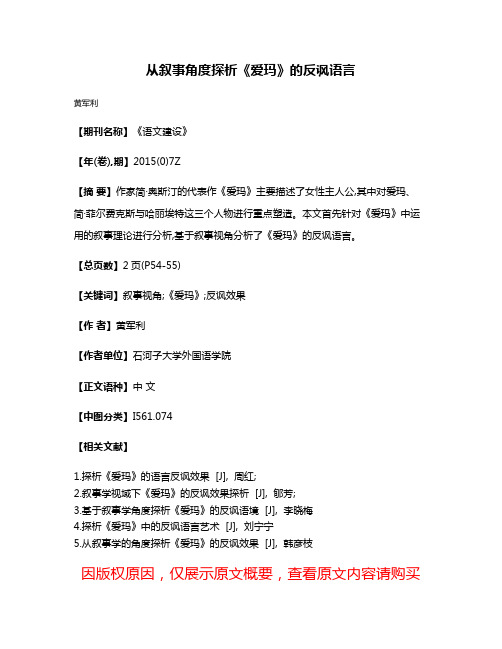
从叙事角度探析《爱玛》的反讽语言
黄军利
【期刊名称】《语文建设》
【年(卷),期】2015(0)7Z
【摘要】作家简·奥斯汀的代表作《爱玛》主要描述了女性主人公,其中对爱玛、简·菲尔费克斯与哈丽埃特这三个人物进行重点塑造。
本文首先针对《爱玛》中运用的叙事理论进行分析,基于叙事视角分析了《爱玛》的反讽语言。
【总页数】2页(P54-55)
【关键词】叙事视角;《爱玛》;反讽效果
【作者】黄军利
【作者单位】石河子大学外国语学院
【正文语种】中文
【中图分类】I561.074
【相关文献】
1.探析《爱玛》的语言反讽效果 [J], 周红;
2.叙事学视域下《爱玛》的反讽效果探析 [J], 郇芳;
3.基于叙事学角度探析《爱玛》的反讽语境 [J], 李晓梅
4.探析《爱玛》中的反讽语言艺术 [J], 刘宁宁
5.从叙事学的角度探析《爱玛》的反讽效果 [J], 韩彦枝
因版权原因,仅展示原文概要,查看原文内容请购买。
- 1、下载文档前请自行甄别文档内容的完整性,平台不提供额外的编辑、内容补充、找答案等附加服务。
- 2、"仅部分预览"的文档,不可在线预览部分如存在完整性等问题,可反馈申请退款(可完整预览的文档不适用该条件!)。
- 3、如文档侵犯您的权益,请联系客服反馈,我们会尽快为您处理(人工客服工作时间:9:00-18:30)。
式的反讽。奥斯汀在给读者传达当时英 国的道德标 准——社会地位和物质财富是评价一个人综合价值 的标准。而这种隐喻形式的反讽手法正是借助语言
来 完 成 的。
( 二) 哲 学 反讽
《 爱玛》 的哲学反讽主要是通过人物 的主观臆 想 和现实 生活 矛 盾性 实 现 的。我 们 知 道 , 爱 玛 为他 人做媒 的行 为是极好 的, 其初衷也是善 良的 , 然而由 于爱 玛具 有极 强 的个 人 主 观性 , 骄 傲 的性 格使 得她 对事情失去 了正确的判断 , 盲 目地插手别人的私生 活, 却神不知鬼不觉地慢慢地摧毁 了别人应有的幸 福 。最后 , 在爱 玛脱 离 自身 的主观臆 想 , 站在 客观 的 视角对待别人 的事情 时, 所有 的一切 终于明 朗化 。 奥 斯 汀从不 同的角 度 描 述爱 玛 的穿 着 、 打 扮 和 整体
( 三) 情境 反讽
反 讽 手段 在 叙 事文 本 中的运 用极 其 广 泛 , 其形
式很 多 , 小说 《 爱玛 》 就 是其 中一个 典 型 例 子 。反讽 手段 中充 满异 义 的各种 叙述 与评论 充实 了作 品的 内 在意 蕴 , 但 同时也对 读者 提 出了更严 格 、 更 高层 次 的 要求 。反讽需 要读者具备辩 证思维 , 不仅要 观察到作
者在话语方 面有意制造 出的种种假象 或表象 , 而且要 凭借丰 富的实践 经验 与话 语情 境来 构筑 所要 描 述 的
收稿 日期 : 2 0 l 5 —o 6 —1 5 作者简介 : 李 敏( 1 9 7 9 一) , 女, 河南焦作人 , 焦作师范高等专科学 校 , 讲师, 硕士 , 研究方 向: 英美语言文学 。
1
的眼光 看世 界 。如果 盲 目地 依靠 自己 的主 观 想 法 , 那 么势 必就会 脱 离现实 , 更难 以看 清真 实 的 自己。
2 0 1 5年第 1 O期 第3 l 卷 ( 总4 0 6期 )
吉林省教育学院学报
J OU R NA L OF E D UC AT I O NA L I NS T I TU T E OF J 删 P ROV I NC E
No . 1 O. 2 O1 5 V0 1 . 3 l
色彩 , 处处体现道德和经济利益的矛盾冲突, 而作 品 中的这种冲突正是借助反讽艺术完成的。奥斯汀心
里 十分 清楚 , 在 1 9世 纪 的英 国 , 婚 姻具 有 重 要 的经
济作用 , 她认为贫穷 是女人愿 意结婚 的重要理 由。 道德 和物 质二 者 在 价 值标 准 上 的 区别 和 相 通 是 《 爱
值观 。
关键词 : 《 爱玛》 ; 简・ 奥斯汀 ; 反讽 艺术
D O I : 1 0 . 1 6 0 8 3 / j . c n k i . j e i j p . 2 0 1 5 . 1 0 . 0 0 1
中图分 类号 : I 5 6 1
文献标识码 : A
文章 编号 : 1 6 7 1 -1 5 8 0 ( 2 0 1 5 ) l O —O o o 1 —o 2
年轻 、 漂亮 、 经 济宽 裕 的她 , 从 来 都 不 担 心 自己 的婚 姻大事 , 还 一 度热 衷 于 为 他 人 做媒 。她 按 照 自己 内
域才应该出现的名词 , 而奥斯汀却用在了对人们道德
标 准 的评价 和判断方面 , 在很 大程度 上是一 种隐喻 形
心 的想法 , 为哈莉艾特安排无数次恋爱 , 却不断招来 嘲笑与讽刺。故事 的最后 , 哈莉艾特认 为 自己爱上 奈特莉 时, 爱玛才从梦 中惊醒, 发觉奈特莉是 自己所 爱 的人 。因此 , 爱玛开始放弃 自己不结婚的天真想 法, 与奈特 莉先 生喜 结 连理 。 简・ 奥斯汀是一个反讽创作大师, 《 爱玛》 是奥 斯 汀 在艺术 领 域达 到 鼎 盛 时 期 的小 说 , 得 到 了诸 多 批评家较高的评价 。简 ・ 奥斯汀高超反讽手段与结 构消除的时候 , 正是爱玛的再教育结束之时, 也是爱 玛 拥有 幸福 的时刻 。在 《 爱玛》 这部小说中, 女 主人 公爱玛 的众多错误是 由多种形式的反讽手段展现出 来 的, 包括 语 言反讽 、 哲 学反讽 以及情 境反 讽 。 二、 基 于 言语行 为 理论视 角 的《 爱 玛》 反 讽 艺术
小说《 爱玛》 简述 《 爱玛》 描 述 的是女 主人公 爱玛 的爱 情故 事。
一
、
玛》 反讽 的主题 。“ 很乐意 回收爱 过别人 的屈 辱 ” “ 对 身心两方 面 都 没有 增 添什 么实 质 上 的损 害 ” 这 两 句 中, 分别 出现了“ 回收 ” 和“ 增 添” 这 些 只 有 在经 济 领
To t a l No . 4 0 6
《 爱玛》 中 的反讽艺术 : 基于言语行为理 论的视 角
李 敏 Biblioteka ( 焦作 师 范 高等 专科 学校 , 河南 焦作 4 5 4 0 0 0 )
摘要 : 简・ 奥斯 汀是英 国杰 出女性 小说 家 , 被世人 赞誉 为反 讽 大师。其代表作 《 爱玛》中对反讽 艺术有 高超的运 用 , 其中 包括语 言反讽 、 哲 学反讽 和戏剧 性反 讽 。通过 运 用 多种反 讽 , 奥 斯 汀不 露 声 色地批 判 了当时英 国人 的婚 姻 状 况和社 会 价
形象 , 意在 向读 者传 递爱玛 的人 生观 、 世界 观 和价值 观 。在时代 发 展 的潮 流 中 , 我 们 必 须具 体 情 况 具体 分析 , 深入 社会 才能 真正 了解社 会 的需求 , 要 明 白事 物 是不 以人 的意志 为 转 移 的 , 我们 不 能 简 单地 依靠 自己的主观 性来 判断 问题 , 更应 该用 一种 客观 、 全 面
